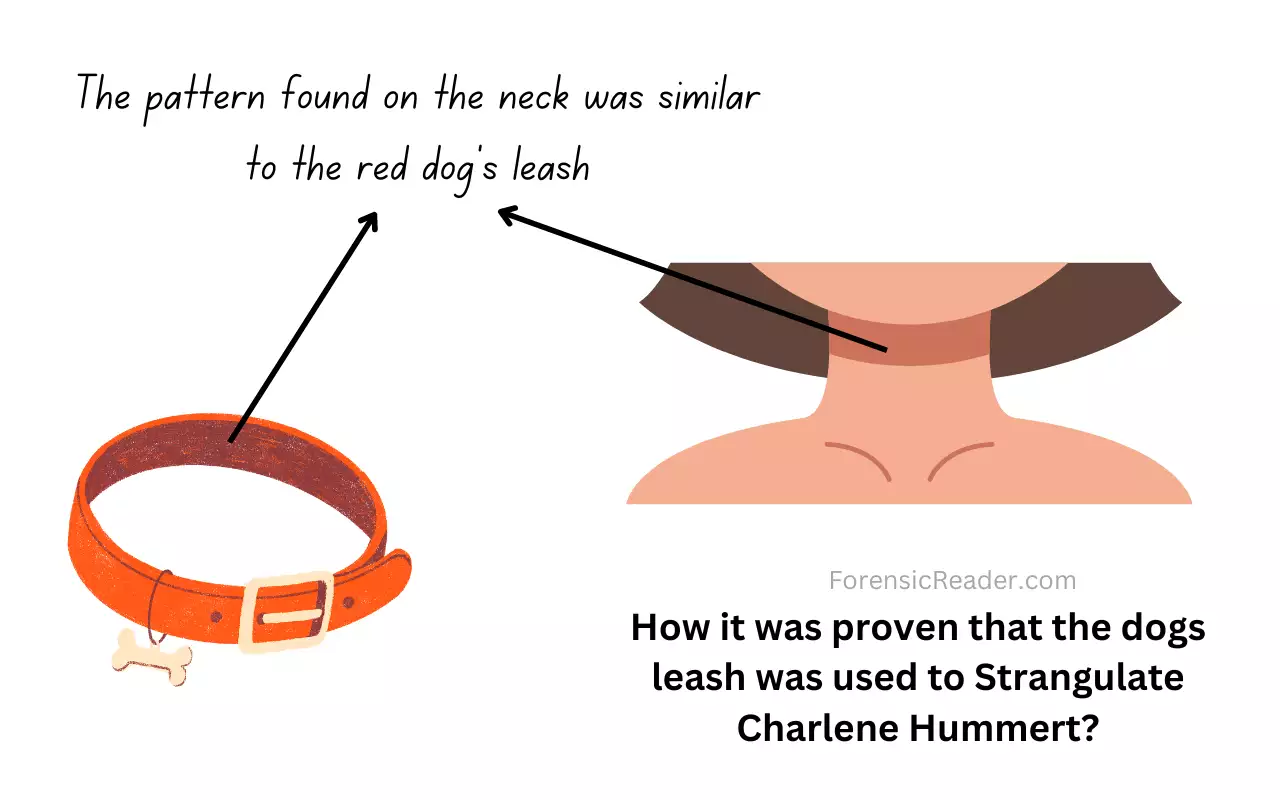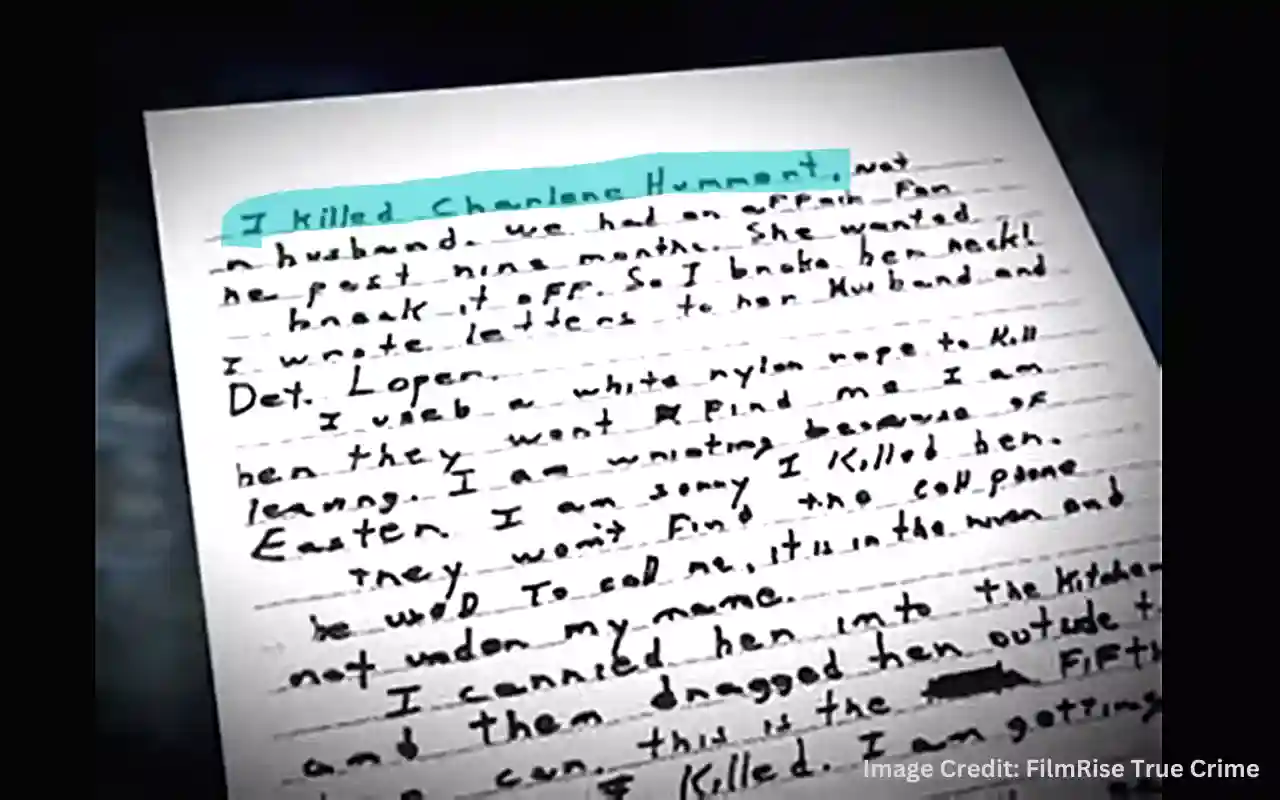How Charlene Hummert Died and Brian Hummert Caught? (Summary)

- Year of Incident: January 2004
- Victim: Charlene Hummert
- Culprit: Brian Hummert
- Forensic Files Case: A Tight Leash (Season 11, Episode 30)
Charlene Hummert (48 years old) lived in Pennsylvania with her husband Brian Hummert and three children. She was a victim of stalking activities in 2001. Police increased surveillance but the stalker wasn’t arrested.
On 21st March 2004, Brian and his son David reported to the police about Charlene’s disappearance. Police found her body in her SUV near a supermarket store. The autopsy revealed ligature strangulation as the cause of death.
The supermarket’s security camera footage was unable to get clear footage of the murderer. However, even after the enhancement, police could only obtain general descriptions, such as he was wearing a blue parka jacket, wool hat, and red gloves. He also purchased dog biscuits.
The height of the culprit, as determined by Forensic Photogrammetrist Williamson, was 5ft 6 inches using the floor tiles dimension of the grocery store.
The dirt sample on Charlene’s clothes revealed a forensic match with the soil on the driveway of Charlene’s house.
On searching Brian’s house, police found a dog’s leash whose pattern matched the ligature marks on Charlene’s neck area. They also found a blue parka jacket in his office.
Meanwhile, police received a letter stating Johns as the killer. However, it was proven a mislead.
Forensic linguist, Dr. Robert Leonard, analyzed the killer’s letter, the stalker’s letter, and Brian’s writings and concluded that all are written by Brian.
On account of these evidences, Brian Hummert was arrested.
Forensic Evidence Against Brian Hummert
| Types of Evidence | Forensic Significance |
|---|---|
| 1. Grocery store’s footage | The original footage was unable to give clear recognition of the person but get an idea about his clothing. Using photogrammetry, the height of the suspect was around 5ft 6 inches. |
| 2. Dirt on Charlene’s clothes | Dirt traces contain carborundum, magnetite, and iron, suggesting the profession could be grinding, or machinery related. Matches with dirt collected from the driveway lead to the conclusion of Charlene being dragged from her own house. |
| 3. Dog’s leash | Found in Hummert’s house. The ligature pattern matches the dog’s strap. |
| 4. Stalker’s letter, Killer’s letter, and Brian’s writings | Linguistic study revealed the presence of negative contractions in all documents leading to the involvement of Brian in Charlene’s murder. |
Brian Hummert’s Punishment and Conviction
Based on the above forensic evidences Brian Hummert was arrested for murdering Charlene Hummert.
In October 2006, forensic reports and case conclusion was presented before jurors. The jury convicted him of first-degree murder. But he managed to appeal for a retrial.
But retrial wasn’t gave a different result.
He was again convicted of first-degree murder by the court in May 2012 and sentenced to life imprisonment without the possibility of parole.
Who were Brian and Charlene Hummert and Their Family?
Brian and Charlene Hummert were a married couple for more than 20 years. They have 3 children: David, Tracey, and Dean.
Charlene Hummert was a kind, religious person. She worked as an administrative assistant for the state of Pennsylvania. She had a good relationship with her children.
However, the married life of Brian and Charlene was not good as they regularly had arguments. Brian had a history of abusing their children, which was the main reason for their arguments.
Read More: Craig Bailey & Megan Mckernan [A Touching Recollection] Forensic Files Case Study
How Person’s Height was determined using Camera Footage?
James R Williamson (Licensed photogrammetrist) used mathematics and physics to calculate the height of the suspect.
Using the floor tile’s dimension (provided by the store) as a reference, the foot length of the suspect was calculated.
Multiple images of persons with various heights were captured using the same security camera (fixed) at the same positions.
Using the images of persons, a height chart, and a comparative chart was prepared.
Finally, using the height chart, the height of the suspect was calculated to be 5ft 6 inches.
Read More: How height of a person can be determined from a Femur Bone? [A Leg To Stand On] Forensic Files Case
Who are Photogrammetrist? What they do and their Job Profile?
Photogrammetry is the technique for creating 3D reconstructions of 2D images. In other words, it is the process of extracting measurements from images.
So, a photogrammetrist is someone who practices photogrammetry techniques. They collect information about an object and its surrounding by analyzing photographic patterns and images.
The education profile includes a bachelor’s degree in cartography, geography, or surveying.
A photogrammetrist should have the following skills:
- Computer operation skills.
- Decision-making skills.
- Attention to finer details.
- A good application of mathematics and physics in forensics.
Read More: Forensic Photography & Scales: How To Use Them Effectively With Examples
How was soil collected and studied?
On Charlene’s clothing, dirt was found. Investigators sent the dirt samples to two different laboratories. But they were unable to find anything unique.
The sample was then sent to an International microscopist, Skip Palenik for analysis.
Procedure:
- Palenik first extracted fibers from the regions containing dirt on the pants.
- He separated the dirt from the fibers using a tuning fork. [Know how fibers are analyzed by forensic experts]
Result: On analyzing dirt, he found traces of carborundum, magnetite, and traces of iron. This gave the idea that the culprit was involved in machinery-related works i.e. grinding, cutting, etc.
Reference Sample: Investigators collected soil samples outside the house and from the neighborhood places.
On analysis using microscopy, it was found that the dirt on the clothes matches the soil at the driveway of the house. This leads to the fact that Charlene was dragged from the driveway of her own house.
Read similar case: Madison Rutherford, Rhynie & Brigitte Beck [Past Lives] Forensic Files Case Study
How it was proven that the dogs leash was used to Strangulate Charlene Hummert?
On autopsy of Charlene’s body, forensic pathologist Samuel Land confirmed that the cause of death was ligature strangulation.

The comparison of soil leads to the fact that someone from the family may be involved in the murder.
So, police searched Brian’s house with a search warrant. They discovered a red cable that the family claimed to be used as a dog’s collar.
Pattern found on neck in the autopsy report is similar to the red collar of dog.
Pathologist Samuel confirmed
There was a metallic contraption at one end of the leash which matches the abrasion present in the front of Charlene’s neck.
Read More: How did a Cat Snowball Helps Investigators in Solving Case?
How does Forensic Linguistics help in Convicting Brian Hummert?
Forensic linguistics involves the study of dialect, grammar, sentence construction, phonetics, etc in documents for crime analysis.
Investigators received a letter claiming, “John was the killer of Charlene.”

Investigators approached forensic linguist, Dr. Robert Leonard. They hand over all letters including the killer’s letter and the stalker’s letter to the forensic linguist.
On examining the letters, Dr. Robert observed the use of “Ironic Repetition”.
It can be described as the use of the same verb in two consecutive sentences with a change in context.
Example: She wanted to break it off, so I broke her neck.
The presence of ironic repetition in both letters confirms that the letters were written by the same person.
On comparing the letter’s writings with Brian’s writings, Dr. Robert found a similarity in the usage of negative contractions.
Example: I don’t think he isn’t here.
Both letters contain negative contractions but no positive verb contractions. For example:
| 1. Brian’s writings | He isn’t here |
| 2. Stalker’s letter | She can’t, I don’t think, almost didn’t |
On the basis of the above clues, Dr. Robert concluded that suspect Brian Hummert wrote both letters.
References:
- Forensic Files – Season 11, Episode 30 – A Tight Leash [YouTube]
- On the Case: Five Questions For Robert Leonard [Link]
- My dad ………. but my sister stood up for him in court [Link]
- What is Photogrammetry? A Forensic Engineering Overview [Link]
- Trace Evidence Research Presentation [Link]

FR Author Group at ForensicReader is a team of Forensic experts and scholars having B.Sc, M.Sc, or Doctorate( Ph.D.) degrees in Forensic Science. We published on topics on fingerprints, questioned documents, forensic medicine, toxicology, physical evidence, and related case studies. Know More.
